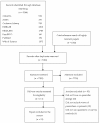Patient and Prescriber Views of Penicillin Allergy Testing and Subsequent Antibiotic Use: A Rapid Review
- PMID: 30082596
- PMCID: PMC6164736
- DOI: 10.3390/antibiotics7030071
Patient and Prescriber Views of Penicillin Allergy Testing and Subsequent Antibiotic Use: A Rapid Review
Abstract
About 10% of U.K. patients believe that they are allergic to penicillin and have a "penicillin allergy label" in their primary care health record. However, around 90% of these patients may be mislabelled. Removing incorrect penicillin allergy labels can help to reduce unnecessary broad-spectrum antibiotic use. A rapid review was undertaken of papers exploring patient and/or clinician views and experiences of penicillin allergy testing (PAT) services and the influences on antibiotic prescribing behaviour in the context of penicillin allergy. We reviewed English-language publications published up to November 2017. Limited evidence on patients' experiences of PAT highlighted advantages to testing as well as a number of concerns. Clinicians reported uncertainty about referral criteria for PAT. Following PAT and a negative result, a number of clinicians and patients remained reluctant to prescribe and consume penicillins. This appeared to reflect a lack of confidence in the test result and fear of subsequent reactions to penicillins. The findings suggest lack of awareness and knowledge of PAT services by both clinicians and patients. In order to ensure correct penicillin allergy diagnosis, clinicians and patients need to be supported to use PAT services and equipped with the skills to use penicillins appropriately following a negative allergy test result.
Keywords: antibiotic resistance; antibiotic stewardship; penicillin allergy; prescribing.
Conflict of interest statement
The authors declare no conflict of interest.
Figures
References
-
- National Institute for Health and Care Excellence . Drug Allergy: Diagnosis and Management of Drug Allergy in Adults, Children and Young People. NICE; London, UK: 2014. - PubMed
-
- Mistry A., Arumugakani G., Toolan J., Ford K., Sandoe J., Wood P., Savic S. Does de-labelling penicillin allergy lead to a respective change in primary care records?; Proceedings of the British Society for Allergy and Clinical Immunology Annual Meeting; Telford International Centre, Telford, UK. 4–6 September 2015.
Publication types
Grants and funding
LinkOut - more resources
Full Text Sources
Other Literature Sources


